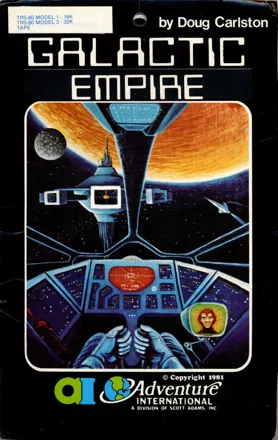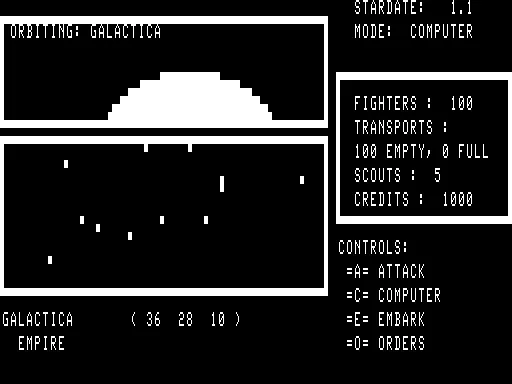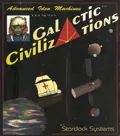Galactic Empire
-
 Galactic Empire
(1984 on
BBC Micro)
Galactic Empire
(1984 on
BBC Micro)
-
 Galactic Empire
(1990 on
DOS,
Amiga,
Atari ST)
Galactic Empire
(1990 on
DOS,
Amiga,
Atari ST)
Description official description
Galactic Empire is the first game in what was to become the Galactic Saga. It is an early example of the space empire game, later to be refined into the 4X genre.
The player takes the role of the commander of the flagship of the planet Galactica. The mission is nothing less than universal conquest: the entirety of the Central Galactic System (consisting of 20 planets laid out in a three-dimensional map) will have to be conquered and held within a time limit of 1000 years.
Each planet has different ratings in technological sophistication and population size. Technological sophistication determines the amount of resistance in establishing air supremacy over a planet, while larger population size increases the difficulty of securing the ground with infantry. Combat takes place automatically, but can be aborted at any time with a retreat order. Once conquered, a planet can be used to build ships, draft troops or collect taxes. Only technologically advanced worlds allow for ship construction, while population size directly influences the amount of troops raised and money raised. Population increases with time, and after a planet has been part of the player's empire for 10 years, the limit of troops to be raised increases from one to two per cent.
Three types of ships can be constructed: fighters are employed in the attack to establish air supremacy, transports are used to ferry troops to the ground, and scouts are sent to establish intel about systems not yet visited by the main fleet.
Unlike in most science fiction set on an interstellar scale, there is no faster-than-light travel or communication in Galactic Empire. Other ships cannot be contacted when not in the same star system as the flagship, and are lost if they do not rendezvous with the main fleet within 5 years of reaching a system. So scout missions and deployment orders for newly constructed ships must be carefully planned in advance, taking into account sub-light traveling times. Should the waiting time for a certain ship to return (or be built) be too long, the commander can be put into suspended animation. Otherwise, the game runs in real time - one year passes in about 4 minutes.
The game interface consists of a command console. It displays a view of the current locale, a calendar, an overview of the fleet's resources, and information about the current situation from Computer Central. A galactic map can be accessed for orientation, while orders are carried out through subordinates: Lt. Starbuck is responsible for scouting missions, Lt. Bayliss for handling planetary production, drafting and taxation, navigator Kirman for setting the fleet in motion towards another system, and Dr. Henderson for putting the commander to cryogenic sleep.
Groups +
Screenshots
Promos
Credits (TRS-80 version)
Reviews
Critics
Average score: 55% (based on 2 ratings)
Players
Average score: 2.9 out of 5 (based on 4 ratings with 0 reviews)
Be the first to review this game!
Discussion
| Subject | By | Date |
|---|---|---|
| Galactic Empire instruction manual ©1979 | Andrew Fisher (700) | May 6, 2023 |
Analytics
Upgrade to MobyPro to view research rankings and price history! (when applicable)
Identifiers +
Contribute
Are you familiar with this game? Help document and preserve this entry in video game history! If your contribution is approved, you will earn points and be credited as a contributor.
Contributors to this Entry
Game added by Terok Nor.
Macintosh added by Manoel Trapier.
Game added October 31, 2011. Last modified July 15, 2024.



















